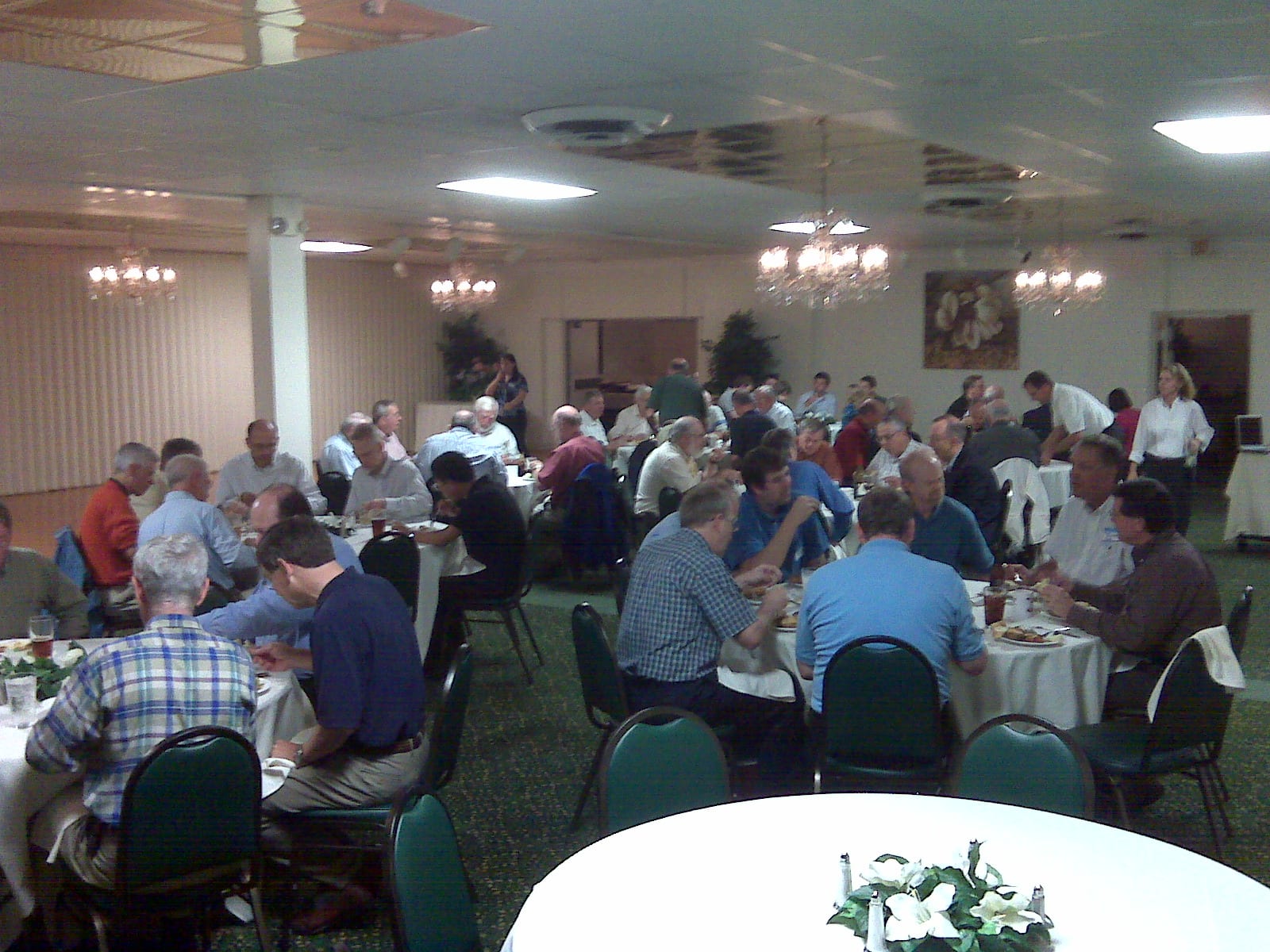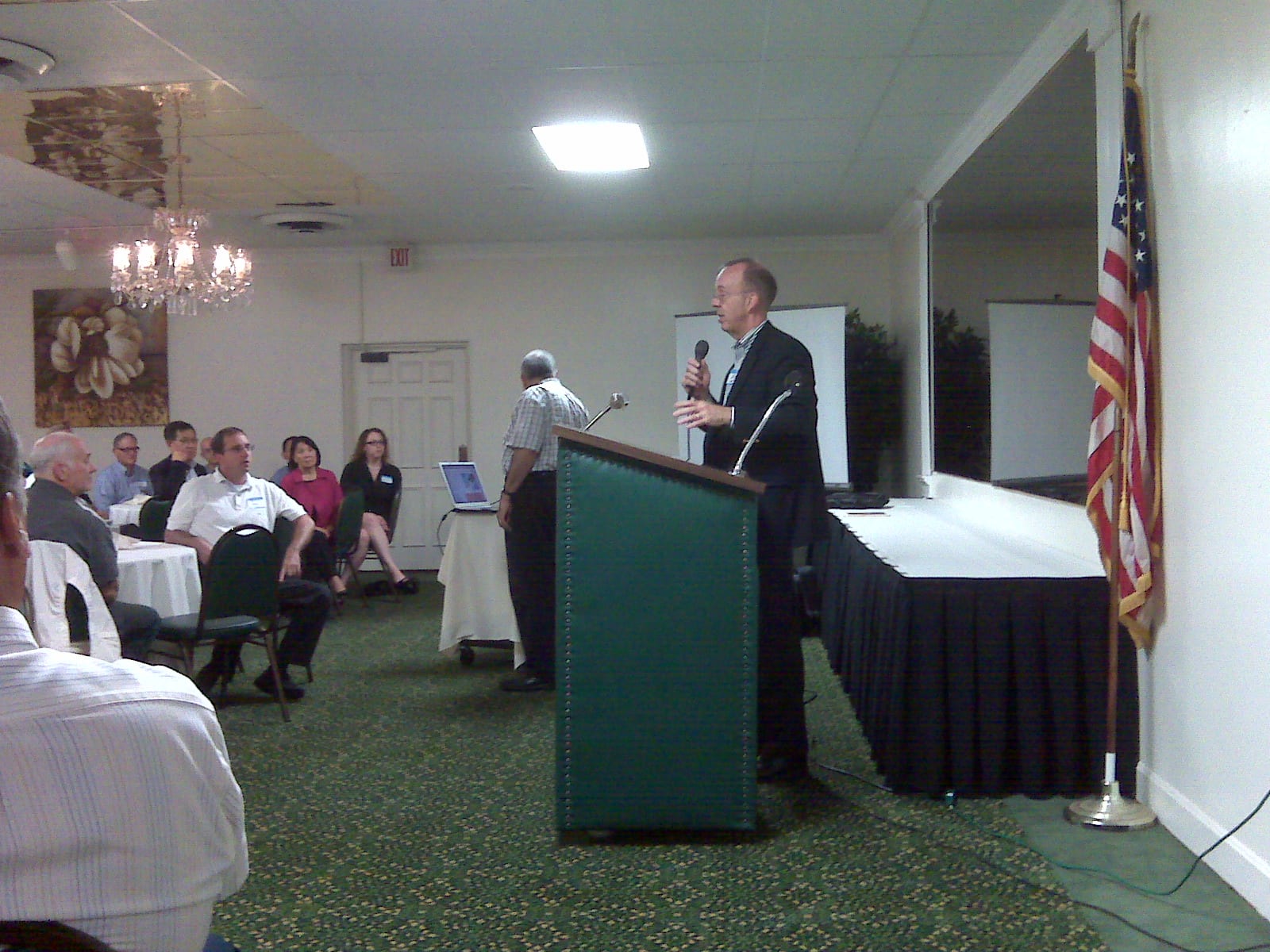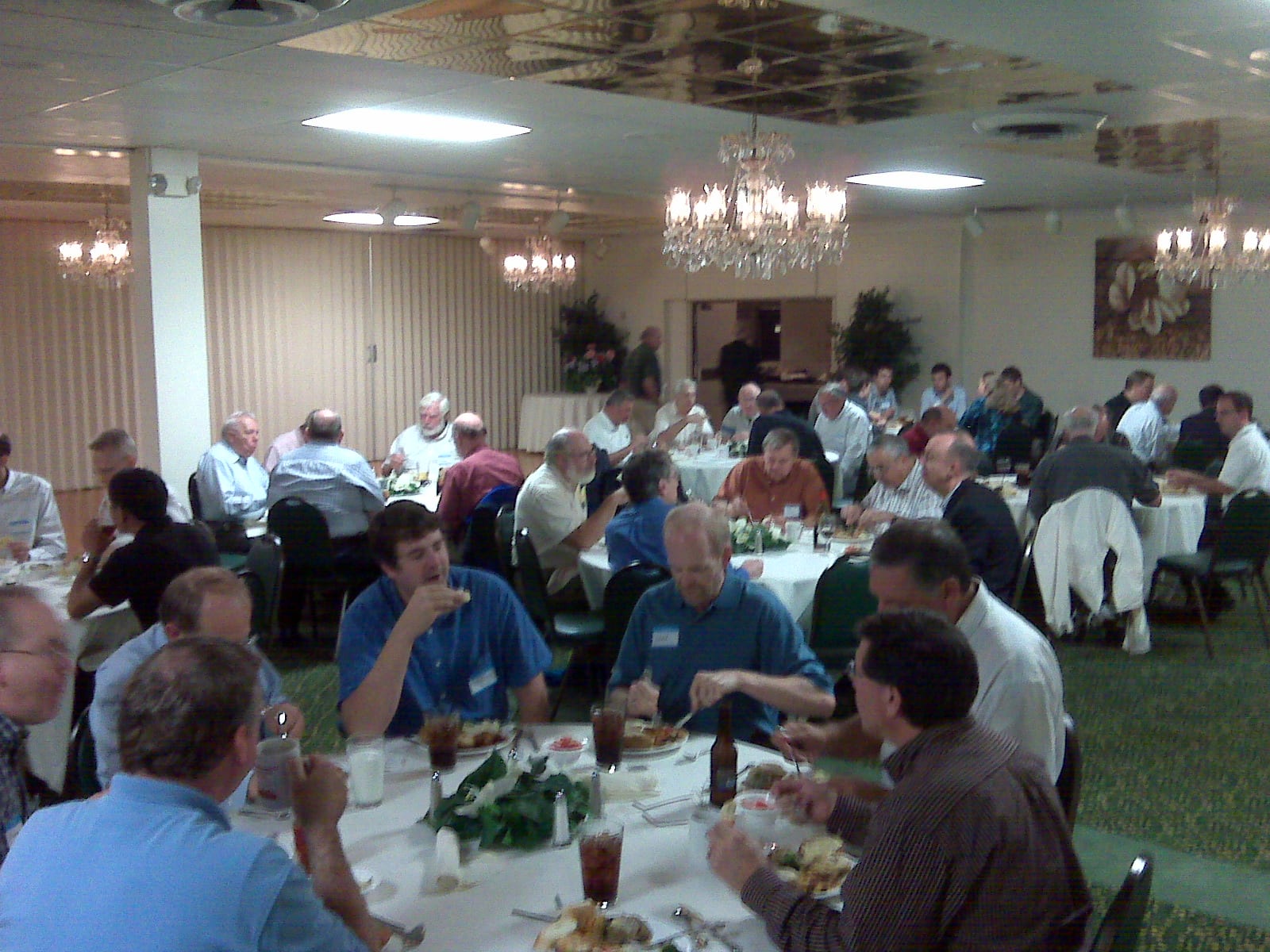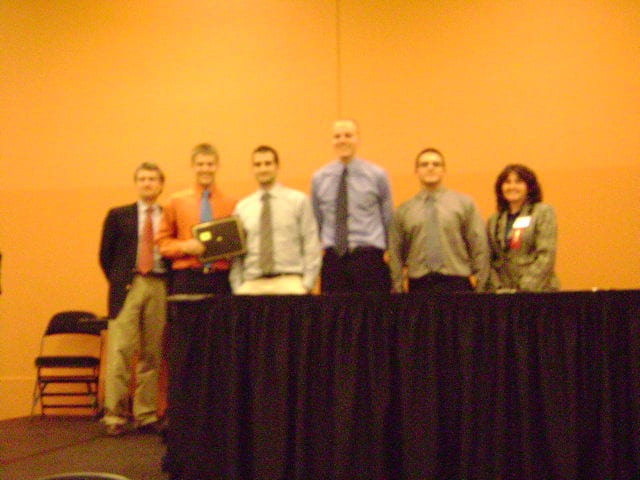Pictures from September Meeting
The following are pictures from the Sept. 24th Section Meeting about the Tesla Roadster. There was an excellent turnout of approximately 120 people!!



The following are pictures from the Sept. 24th Section Meeting about the Tesla Roadster. There was an excellent turnout of approximately 120 people!!



New Cincinnati Section Senior Member
The Cincinnati Section would like to congratulate our newest Senior Member,
J. David Jacobs
whose upgrade application was recently approved.
If you are interested in upgrading your membership to Senior Member, please contact any member of the Executive Committee. You can also see any member of the Executive Committee immediately following any Section Meeting.
NEW MEMBERS
The following individuals are IEEE members who are new to our Section:
Jonathan Adam
Matt Batta
Prabir Bhattacharya
Boyan Dimitrov
Ranran Ding
Danh Do
Mark Ferguson
William Chad Hafer
Stephen Todd Hamblin
Kevin J. Haworth
Steven Hutchinson
Kyle Kauffman
John Mark Kennedy
Aaron Knopp
John Kuhn
Elliott M. Long
Hao Luan
Jorge Moscat Pardos
Katrina Marshall Reffett
Randy Schavel
Samuel F. Slade
Vignesh Subbian
Shawn Wilkening
We wish to welcome these new members to the Cincinnati Section!!!
Scanning the Past: A History of Electrical Engineering from the Past
Submitted by Bob Morrison, Editor
Copyright 1996 IEEE. Reprinted with permission from the IEEE publication, “Scanning the Past” which covers a reprint of an article appearing in the Proceedings of the IEEE Vol. 84, No. 3, March 1996.
John G. Brainerd and Project PX (ENIAC)
Fifty years ago this month, the PROCEEDINGS OF THE INSTITUTE OF RADIO ENGINEERS (IRE) included an article by John G. Brainerd on Project PX or ENIAC which had recently been completed at the University of Pennsylvania. The author had served as supervisor of the wartime project and was a professor of electrical engineering at the university. ENIAC was an acronym for Electronic Numerical Integrator and Computer and the article characterized it as a “mathematical robot” and “the first all-electronic general purpose computer.” Brainerd mentioned that the machine occupied a 30 x 50 foot room and contained approximately 18,000 electron tubes. He explained that ENIAC had been conceived originally as a machine to solve ballistics equations more quickly and accurately but was now being discussed “in connection with problems which were not even thought of when development began.”
IEEE-USA Unveils Digital Archives, Features Organization’s Four Decades of Service
WASHINGTON (4 September 2009) — IEEE-USA is building a digital archive featuring documents and photos of its 36-year history of promoting the careers and public policy interests of U.S. IEEE members. Part of the IEEE-USA History Project, the archive features:– An overview of the first four decades of IEEE-USA from 1973-2009
— A listing of IEEE-USA’s leaders from 1973 to date, including photos of boards of directors from 1998
— A detailed description of IEEE-USA’s formation and its first 10 years (1973-1983), including an IEEE Spectrum special report on the constitutional referendum that added professional activities to the IEEE constitution
— A look at IEEE-USA growth and maturity from 1984-1999, with annual reports covering the 15-year period
— A glimpse of IEEE-USA in the 21st Century from 2000-present, including annual reports from 2002-2008, years in review from 2005-2008, and program handbooks for 2007-2008
— Program histories, including IEEE-USA’s Student Professional Awareness Conferences (S-PACs)John Meredith, IEEE-USA’s 2007 president, is leading the IEEE-USA History Project. Meredith chaired the 2009 IEEE Conference on the History of Technical Societies, in Philadelphia from 5-7 August, and made a presentation on IEEE-USA history.
To view the digital archive, go to http://ieeeusa.org/about/history/index.html.
The Tesla Roadster: a plug-in electric sports car – demonstration and description
DATE: Thursday, September 24, 2009
PLACE : Raffel’s – 10160 Reading Road (see below for directions)
TIME : 5:30 p.m. to 6:00 p.m. – Social Time
6:00 p.m. to 7:00 p.m. – Dinner
7:00 p.m. to 8:30 p.m. – Presentation
COST FOR DINNER: $10.00 per person – Regardless of Membership or Membership Grade!
NOTE: DINNERS ARE ALWAYS OPTIONAL – YOU MAY ATTEND THE PROGRAM ONLY.
NEW MEMBERS
The following individuals are IEEE members who are new to our Section:
Mark G. Atchison
Gordon C. Baker
Omar Baldridge
R. H. Black
Thomas Blauvelt
Timothy Bueno
Mark A. Burcham
Jeremy Burgess
Richard Nathan Burns
Stephen Caddell
Garry Chapman
Chelsea Chase
Ryan Child
Jacqueline Coates
Israel T. Cortes
Austin P. Crispens
Justin Andrew Daniels
Ian T. Daniher
Kaustubh K. Deshmukh
Heath Edenfield
James Estepp
David Ferguson
Romana Fernandes
Michael P. Fink
Samuel R. Frushour
Ryan Gerken
Adam Gerlach
Amer Ghanem
Phillip Golden
Ryan Grimes
Erik Hajek
Allan K. Hall
Justin Hamm
Michael Harness
Nathaniel Hausrath
Bing He
Misti Hill
Brent Humphrey
Pritesh N. Johari
Andrew Johnson
Jigar Kalaria
Paul J. Kern
Michael Keyes
Thomas Klevinsky
Marvin Allen Knorr
Christian Koch
Paul M. Krieg
Alex R. Kuhl
Roy M. Kulick
Victor Lin
Patrick Lipka
Kuheli Louha
Thomas M. Lucas
Yuliya Malakhova
Jordan Malof
Paul Meredith
Jeff L. Miller
Dirk W. Mooibroek
John Norton
Kevin Pasko
Dale R. Peterson
Benjamin Pierce
Kurt Prenger
Raj R. Reddy
Richard Riccetti
Michael N. Rissover
Michael J. Rust
Chad Aaron Ruttencutter
George Michael Shiekh
Vonise Shoemaker
Evan Blyth Sneath
Sibichen J. Thekveli
Tommy V. Trimeloni
Darren Varga
Ramesh Reddy Vemula
Tim L. Vernier
Paul Vincent
Edward E. Walcott
Nathan A. Walker
Hong Wang
Eric Michael Webb
Richard D. Winters
Huaping Wu
We wish to welcome these new members to the Cincinnati Section!!!
Scanning the Past: A History of Electrical Engineering from the Past
Submitted by Bob Morrison, Editor
Copyright 1996 IEEE. Reprinted with permission from the IEEE publication, “Scanning the Past” which covers a reprint of an article appearing in the Proceedings of the IEEE Vol. 84, No. 2, February 1996.
The Birth of the Term “Microwaves”
The term microwaves was used for the first time in an international journal in the October 1932 issue of the PROCEEDINGS OF THE INSTITUTE OF RADIO ENGINEERS (IRE) in an article by Nello Carrara: “The detection of microwaves” (the original manuscript was received by the Institute on April 2, 1932). .
This term has been, since then, commonly used to indicate those electromagnetic waves with wavelength ranging from 1 mm to 1 m. These limits have been arbitrarily defined: in practice they constitute an attempt to define the microwave frequency range as the one located between the frequencies of electromagnetic waves employed for radio and television broadcasting and those of infrared rays.
Unemployment Rate for Electrical Engineers Soars to New Record,
Engineering Jobless Rate Up for Second Consecutive Quarter
WASHINGTON (7 July 2009) — The unemployment rate for U.S. electrical and electronics engineers (EEs) hit a new record in the second quarter, while the rate for all engineers increased for a second straight quarter, according to data released last week by the Department of Labor’s Bureau of Labor Statistics (BLS).”Technology drives our economy, which means engineering unemployment is a bellwether for recovery and job creation,” IEEE-USA President Gordon Day said. “These new data suggest we’ve got a long way to go as the United States attempts to regain its economic footing.”
The news for EEs was particularly bad as the jobless rate more than doubled from 4.1 percent in the first quarter to a record-high 8.6 percent in the second. The previous quarterly record was 7 percent, in the first quarter of 2003.

Chris Direnzi (EE), Mike Ratterman (EE), Josh Rarick (EE), Jon Skeans (EE), Dr. Fred Beyette (advisor). Smart Heart is a project that has been designed to design, track, and follow specific workouts for users. From a hardware standpoint, we integrated an accelerometer, a GPS locator, and a user interface with a PIC microcontroller. The Smart Heart device has a computer software interface, where the user can enter specific workout goals. Our software designs a workout specific to the user and downloads the workout plan to our portable Smart Heart system. The system suggests activities based on the user’s goals, such as running/walking, push-ups and sit-ups. The onboard GPS tracks the distance and speed of the user’s runs. During push-ups and sit-ups, the accelerometer counts the number of repetitions the user completes. After a work-out, the user downloads the data to the computer program for a workout summary and compares it to previous workouts. While a production quality product like this project would need to be small (possibly watch sized), our goal is functionality, not physical size. We will identify how the product could be made smaller, but we will not actually fabricate the portable sized device. We want to research ways to make our GPS function in low signal environments (indoors), but perfecting a low signal GPS system is beyond the scope of our project.
Sam Banzhaf (CE), Adam McClain (CS), Gary Sigrist (CE), Jeff Webster (CS), Dr. Fred Annexstein (advisor). In the last five years, music distribution has seen a shift from physical media such as CDs to digital forms such as MP3s. For major artists iTunes is the dominant seller of MP3s. Artists without a record label have a difficult time promoting their music, and the prevalent method for doing this digitally is via MySpace Music. Given the difficult nature of promoting and distributing music by independent and local music artists, it would be beneficial for both the artists and the listeners to have an easy way to increase exposure in the music industry.While independent artists can have their music sold on iTunes, it provides no active promoting of their music. Furthermore, samples of songs are limited to the first 30 seconds, which often does not give a robust preview of the song. For artists who use MySpace as a means to promote their music, the quality is poor, searching is cumbersome, service is unreliable, and sales again yield little or no profit. This calls for an online service that allows independent artists to easily promote their music, as well asallow potential fans to easily find new music.The overall goal of our Bragi Online Music Recommendation software is to provide musical artists with an easy way to promote their music, and for potential fans to be able to easily find artists according to their musical tastes via an intuitive and adaptive recommendation engine.
Matt Harbaugh (CS), Greg Hill (CS), Kurt Prenger (CS) , Dr. Chia-Yung Han (advisor). Microsoft’s video game system, Xbox 360, has an online marketplace, Xbox Live Marketplace, where users can purchase and download smaller, less expensive games (compared to retail games purchased at a store) to play on their systems. They have recently released the XNA Game Studio for developers to create and distribute their games. Prospective developers can use this studio along with Microsoft’s Visual C# Studio to create games to distribute on the Xbox Live Marketplace. There is an online community that reviews and approves games for distribution. If a game is approved, it will be released on the Xbox Live Marketplace.Our design idea takes the game play of Tetris but places a new twist on it: along with being able to rotate the individual blocks, the player will be able to rotate the entire playing field. Two-player battle mode will also be incorporated with special blocks that give bonuses to players as well as other opportunities to disrupt an opponent’s playing area.In the current video game market, there are very few video games that expand upon a previous idea to make something unique and popular. Creating a game similar to Tetris with the additions mentioned above would fill this gap in the market. It will also require a lot of mathematical, graphical and programming knowledge.
Dinsmore & Shohl is actively recruiting for a solid Cisco Engineer. Candidate must be very strong on route/switching, VPNs, Wireless technologies, MPLS, EIGRP, OSPF, BGP, QoS. Ideal candidate will also have additional exposure to WAAS, VoIP, IDS, ACS. Standard Cisco Certifications a plus. Dinsmore & Shohl offers a very challenging technical environment where increasing technical skills and creativity are always encouraged.
The position will be located in downtown Cincinnati. Minimal travel to regional offices.
Please contact Juanen L. Wong if interested. Contact information is below.
Dinsmore & Shohl LLP
Juanene L. Wong
Chief Information Officer
255 East Fifth Street
Suite 1900
Cincinnati, OH 45202
Phone: (513) 977-8147
juanene.wong@dinslaw.com, www.dinslaw.com